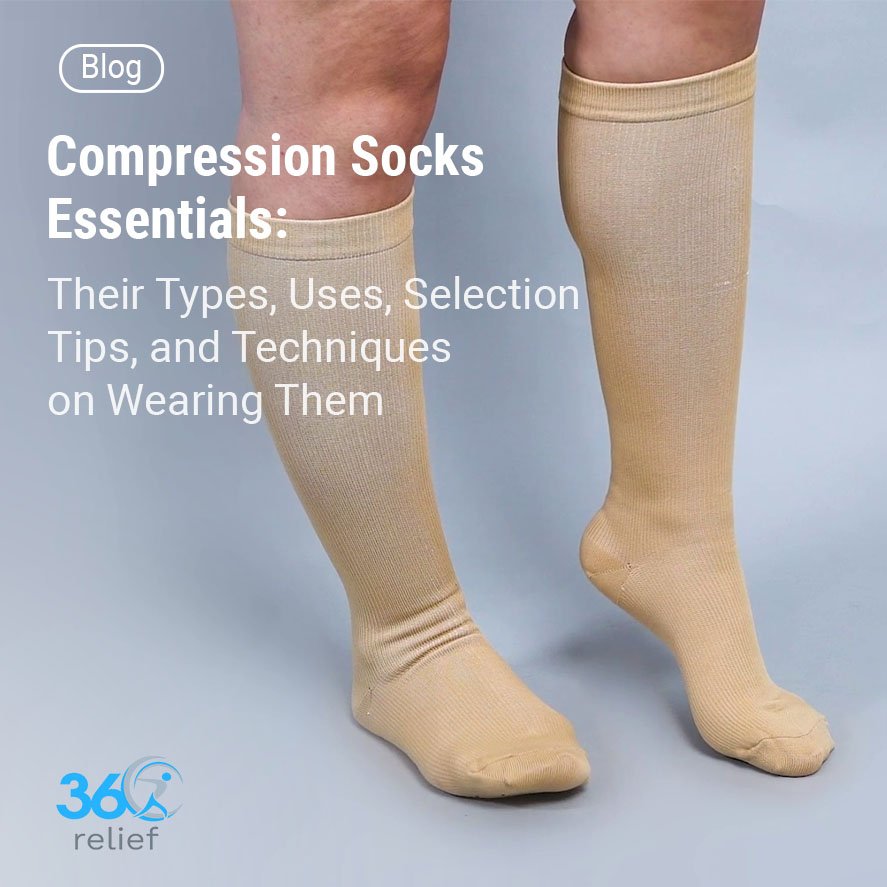Compression socks are specialised garments, different from normal socks, helping provide targeted compression or pressure to legs and feet. Whether you are a regular traveller, a professional nurse, participate in athletic activities or an expectant mother, you may suffer from poor blood circulation problems to some extent. Here come compression socks that help boost your blood circulation, avoiding the risks of clot formation or any other circulation-related injuries. This article is a detailed account of the compression socks essentials. Throughout this article, we have discussed the common types and uses of compression socks. As well as this, you can get professional tips on choosing the right option for you. We have concluded this discussion with the best techniques and guide on wearing compression socks. So, let’s begin our discussion here;
Table of Contents
ToggleTypes of compression socks
Compression socks are designed in different ways (compression levels) to meet the specific needs of users or wearers. For example, some compression socks are best for eliminating swelling and discomfort, some are best at reducing fatigue, some are best at improving circulation, and so on. The following are the common types of compression socks used on a large scale:
1. Graduated compression socks
Graduated compression socks are designed to provide pressure or compression at different levels. This pressure is high at the bottom or ankle and gradually decreases upwards. Graduated compression socks help in a variety of conditions, including preventing blood from pooling, increasing blood circulation, minimising swelling, and reducing the risk of deep vein thrombosis, also known as DVT.
2. Anti-embolism compression socks
Anti-embolism compression socks are specifically designed to be used in medical conditions to prevent blood clot formation. These socks help in exerting consistent but moderate pressure on the legs. These socks can be beneficial for a variety of conditions, including promoting blood flow, preventing venous stasis, and reducing the risk of clot formation. The socks are specifically recommended for wear by patients who are recovering from surgery or are immobile.
3. Non-medical socks or hosiery
Non-medical socks or hosiery are designed to offer mild compression levels. These socks are often used for fatigue reduction, general leg comfort, and offering a slight boost to blood circulation. These are not designed to treat any medical condition. These can be worn for daily life routines when you feel discomfort.
Compression socks styles
Compression socks are designed in different styles to meet the specific requirements of individual people. Here we come with the top styles used to design compression socks:
- Waist high compression socks (compression tights): These compression tights are best at providing compression to the entire leg and waist, addressing the issues related to varicose veins, poor blood circulation, and swelling.
- Thigh-high compression socks: These socks are designed to target the calf and thigh areas, helping in preventing several conditions, including leg fatigue, and DVT. They are also best at improving blood flow in the legs or thighs.
- Knee-high compression socks: These compression socks provide compression to the entire calf or lower leg – from ankles to just below the knee joint. These are best at reducing mild to moderate swelling, and discomfort, and improving circulation.
- Compression leg sleeves: These socks are specifically designed to provide compression to the calves. These are ideal socks for athletes as they help reduce muscle tension and vibrations during physical activities.
Uses or Benefits of Compression Socks
From preventing pain, swelling, and fatigue during sports, travelling and daily life routines, to promoting recovery or healing from injury or surgery, compression socks are worn for a variety of purposes. Below are the common uses of compression socks:
1. Compression socks for flying
People involved in long hours of flights may be prone to swelling, leg fatigue, or circulation problems in the lower legs. Wearing compression socks for flying can help improve blood circulation and reduce the risk of blood clot formation. Thus, they help enhance overall comfort during long-hours flights.
2. Compression socks for nursing
Nurses are required to work for long hours on their feet. This practice may make them prone to leg discomforts, including pain, fatigue, and swelling. Wearing compression socks helps nurses reduce the chances of swelling and pain during long shifts or duties.
3. Compression socks for pregnancy
Hormonal changes and other conditions during pregnancy can cause pain and swelling in the lower legs. Wearing compression socks for pregnancy helps reduce leg swelling, promote blood circulation, and manage fluid retention, contributing to a healthy pregnancy experience.
It’s crucial to know when to wear compression socks during pregnancy. For this purpose, you must consult your healthcare professionals and let them decide when and how to wear compression socks to make your pregnancy session healthy.
4. Compression socks for venous problems
Venous diseases may result from several medical conditions and other reasons. These diseases may include deep vein thrombosis, varicose veins, spider veins, and others. The common reason behind these venous problems is poor blood circulation. Wearing compression socks for venous problems helps improve blood circulation in the lower legs, improving the symptoms of venous problems.
5. Compression socks for sports
Athletes and other sports professionals involved in continuous running and other strenuous activities may experience pain, swelling, and fatigue in the lower legs. Wearing compression socks for sports helps improve blood circulation throughout the sports session, helping reduce the risks of circulation problems.
6. Compression socks for everyday life
People who are prone to leg problems during their normal routine or everyday lifestyle are also recommended to wear compression socks. Wearing compression socks helps keep your legs warm and active throughout their daily activities, helping prevent the chances of circulation-related injuries.
How to choose the best compression socks
Choosing the right type of compression socks guarantees maximum benefits. Here we come with the possible tips, to help you choose the right compression socks according to your needs:
- Appropriate compression level: Compression socks are available from high compression levels (40 – 50 mmHg) to moderate compression levels (20 – 40 mmHg), and low compression levels (20 mmHg). Consult your healthcare professionals and they will recommend the compression level according to your needs.
- Best type: We have mentioned above the different types and styles of compression socks. You need to choose the right option for maximum benefits.
- Material: Compression socks are designed with different materials, including nylon, spandex, and others. Ensure you choose a moisture-wicking and breathable material. Also, ensure the material is suitable for your skin.
- Size: Compression socks are available from small, to medium, large, and even extra-large sizes. Some compression socks are flexible enough that they come under the one-size-fits-all category. Ensure you choose the right size to get maximum comfort.
You must follow all other instructions, as recommended by your GP or healthcare professionals, maximising the results or benefits.
How to wear compression socks?
The wearing guide for compression socks comprises different factors, including the recommended time, the right type or size, and the compression levels. It is advisable to ask your GP or healthcare advisors to choose the right type and size. As well as this, ensure that you wear the compression socks under the time period set by your healthcare professional. Remember that wearing compression socks for a long or extended period may cause circulation or skin problems. Also, ensure that the compression socks are properly fitted. Too much tight compression socks may cut blood circulation, on the other hand, loosely fitted compression socks may not be able to provide needed compression.























